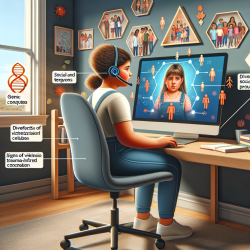Child language disorders have been a focal point of educational and therapeutic intervention for decades. The journey of understanding, diagnosing, and treating these disorders has been marked by significant shifts, influenced by interdisciplinary research and evolving pedagogical approaches. Reflecting on the past 25 years, as detailed in Robin S. Chapman's comprehensive retrospective, "Child Language Disorders: A Twenty-Five Year Retrospective," provides invaluable insights for practitioners looking to enhance their skills and approaches in this challenging field.
The early years of child language disorder research were characterized by a relatively narrow focus on delayed speech and language development, often without a clear understanding of the underlying complexities. Pediatric advice, as Chapman notes, typically leaned towards a 'wait and see' approach, with the expectation that many children would naturally 'catch up' by school age. However, as the field has evolved, so too has our appreciation for the nuanced interplay of cognitive, linguistic, and environmental factors that contribute to language disorders.
One of the most significant shifts highlighted in Chapman's retrospective is the move from a purely behavioral understanding of language development to a more nuanced, rule-based and cognitive framework. This transition was largely influenced by the pioneering work of Noam Chomsky, who challenged existing behavioral theories and introduced the concept of an innate linguistic capability. This paradigm shift underscored the importance of understanding the generative rules of language, setting the stage for more sophisticated approaches to diagnosis and intervention.
For practitioners, this evolution underscores the importance of a multifaceted approach to language disorders, one that considers not just the symptoms but the underlying linguistic structures and cognitive processes. It invites a deeper engagement with linguistic research and a commitment to ongoing professional development to stay abreast of the latest theories and methodologies.
Chapman's retrospective also highlights the significant influence of interdisciplinary research on the field. Insights from psychology, linguistics, and even philosophy have enriched our understanding of how children acquire language and the nature of language disorders. This interdisciplinary approach has led to more holistic assessment and intervention strategies, emphasizing the need for practitioners to adopt a broad, informed perspective on language development.
Moreover, the past 25 years have seen a growing recognition of the role of the environment and social interaction in language development. Studies have demonstrated the impact of the language learning environment, parental engagement, and socio-economic factors on children's language acquisition. This body of research supports a more inclusive approach to intervention, one that extends beyond the individual child to consider the broader context of language development.
Practitioners can draw several key lessons from this 25-year retrospective. First, it is clear that a deep, research-informed understanding of language development and disorders is crucial. Engaging with the latest research, whether through academic journals, conferences, or professional networks, is essential for effective practice.
Second, the importance of an interdisciplinary approach cannot be overstated. By integrating insights from linguistics, psychology, education, and other related fields, practitioners can develop more effective, nuanced intervention strategies that address the complex needs of children with language disorders.
Third, the retrospective highlights the need for practitioners to consider the broader context of a child's language development, including environmental, social, and emotional factors. This holistic perspective is critical for developing comprehensive, individualized intervention plans that support not just linguistic development but overall well-being.
In conclusion, Chapman's retrospective offers a rich, insightful overview of the evolution of child language disorder research and practice over the past 25 years. For practitioners, it serves as a reminder of the importance of continuous learning, interdisciplinary collaboration, and a holistic approach to intervention. By embracing these principles, we can enhance our skills and effectiveness in supporting children with language disorders, helping them to achieve their full communicative potential.
To read the original research paper, please follow this link: Child Language Disorders: A Twenty-Five Year Retrospective.










